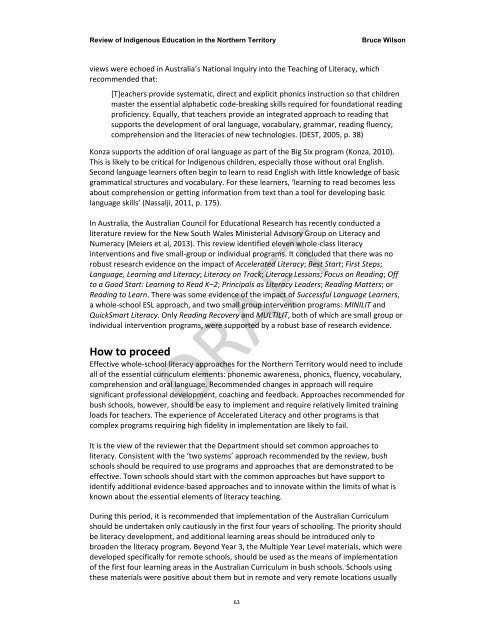Indigenous-Education-Review_DRAFT
Indigenous-Education-Review_DRAFT
Indigenous-Education-Review_DRAFT
Create successful ePaper yourself
Turn your PDF publications into a flip-book with our unique Google optimized e-Paper software.
<strong>Review</strong> of <strong>Indigenous</strong> <strong>Education</strong> in the Northern Territory<br />
Bruce Wilson<br />
views were echoed in Australia’s National Inquiry into the Teaching of Literacy, which<br />
recommended that:<br />
[T]eachers provide systematic, direct and explicit phonics instruction so that children<br />
master the essential alphabetic code‐breaking skills required for foundational reading<br />
proficiency. Equally, that teachers provide an integrated approach to reading that<br />
supports the development of oral language, vocabulary, grammar, reading fluency,<br />
comprehension and the literacies of new technologies. (DEST, 2005, p. 38)<br />
Konza supports the addition of oral language as part of the Big Six program (Konza, 2010).<br />
This is likely to be critical for <strong>Indigenous</strong> children, especially those without oral English.<br />
Second language learners often begin to learn to read English with little knowledge of basic<br />
grammatical structures and vocabulary. For these learners, ‘learning to read becomes less<br />
about comprehension or getting information from text than a tool for developing basic<br />
language skills’ (Nassalji, 2011, p. 175).<br />
In Australia, the Australian Council for <strong>Education</strong>al Research has recently conducted a<br />
literature review for the New South Wales Ministerial Advisory Group on Literacy and<br />
Numeracy (Meiers et al, 2013). This review identified eleven whole‐class literacy<br />
interventions and five small‐group or individual programs. It concluded that there was no<br />
robust research evidence on the impact of Accelerated Literacy; Best Start; First Steps;<br />
Language, Learning and Literacy; Literacy on Track; Literacy Lessons; Focus on Reading; Off<br />
to a Good Start: Learning to Read K–2; Principals as Literacy Leaders; Reading Matters; or<br />
Reading to Learn. There was some evidence of the impact of Successful Language Learners,<br />
a whole‐school ESL approach, and two small group intervention programs: MINILIT and<br />
QuickSmart Literacy. Only Reading Recovery and MULTILIT, both of which are small group or<br />
individual intervention programs, were supported by a robust base of research evidence.<br />
How to proceed<br />
Effective whole‐school literacy approaches for the Northern Territory would need to include<br />
all of the essential curriculum elements: phonemic awareness, phonics, fluency, vocabulary,<br />
comprehension and oral language. Recommended changes in approach will require<br />
significant professional development, coaching and feedback. Approaches recommended for<br />
bush schools, however, should be easy to implement and require relatively limited training<br />
<strong>DRAFT</strong><br />
loads for teachers. The experience of Accelerated Literacy and other programs is that<br />
complex programs requiring high fidelity in implementation are likely to fail.<br />
It is the view of the reviewer that the Department should set common approaches to<br />
literacy. Consistent with the ‘two systems’ approach recommended by the review, bush<br />
schools should be required to use programs and approaches that are demonstrated to be<br />
effective. Town schools should start with the common approaches but have support to<br />
identify additional evidence‐based approaches and to innovate within the limits of what is<br />
known about the essential elements of literacy teaching.<br />
During this period, it is recommended that implementation of the Australian Curriculum<br />
should be undertaken only cautiously in the first four years of schooling. The priority should<br />
be literacy development, and additional learning areas should be introduced only to<br />
broaden the literacy program. Beyond Year 3, the Multiple Year Level materials, which were<br />
developed specifically for remote schools, should be used as the means of implementation<br />
of the first four learning areas in the Australian Curriculum in bush schools. Schools using<br />
these materials were positive about them but in remote and very remote locations usually<br />
63


